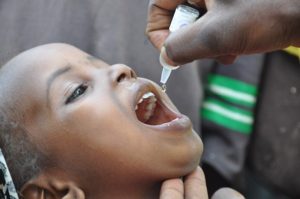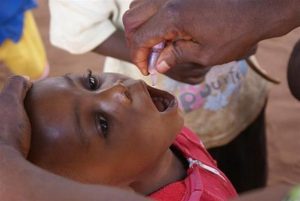More than 72 million children to be immunized across 15 countries to tackle remaining risks

Rod Curtis/WHO
Dakar/Brazzaville, 26 October – This week, Africa seizes an unprecedented chance to drive out polio when 15 countries across the continent launch a synchronized mass immunization campaign to reach 72 million children, capitalizing on gains made this year. A total of some 290,000 vaccinators have been mobilized to go door-to-door to deliver two drops of oral polio vaccine (OPV) to every child under five in areas considered at “highest risk” of polio transmission.
Africa’s leaders demonstrated unprecedented cooperation and commitment to carry out a series of synchronized immunization activities in 2009 and in March and April, 2010, following the spread of the disease from Nigeria which came to infect 24 countries across west and central Africa and in the Horn of Africa. As a direct result of these immunization campaigns, the polio outbreaks have slowed to a trickle. Across west Africa, only Liberia and Mali have recorded any cases in the past five months, while Nigeria – the only country in Africa never to have stopped polio transmission – has slashed polio by 98% in the past year.
However, recent weeks have shown the very real risks of not completing eradication, with a September case in Liberia confirming residual transmission, a new importation of type 3 wild poliovirus into Mali (the first since 2001), and a case in Uganda, which had been polio-free for more than a year. In all countries, rapid assessments are being conducted to formulate an emergency response plan in which two additional mop-up rounds will be held. All countries in the West Africa sub-region will again conduct two full campaigns in February and March, 2011, but high-quality immunization campaigns must be complemented by enhanced routine immunization and strong disease surveillance.
With the outbreak in Angola (25 cases) having spilled over the border into neighboring provinces of the Democratic Republic of the Congo (28 cases) – these two countries now represent the greatest threat to polio in Africa, having recorded 48 of Africa’s 58 cases in the past six months. However, the virus in DR Congo remains geographically restricted and in Angola, steps by the Government to close vaccination coverage gaps in the most recent campaign – which started on 1 October – saw the percentage of missed children in the key reservoir of Luanda fall from nearly 30% to 13%, while nationally, the percentage of missed children fell from 15% to 8%.
The World Health Organization’s African Regional Director, Dr Luis G. Sambo, acknowledged the recent steps taken by Angola and DR Congo to close vaccination coverage gaps, with the Angolan Minister of Health personally vaccinating children on the streets of Luanda during the October campaign. “In Africa,” Dr Sambo said, “we are seeing the essential government support that can make the difference between success and failure. But much more remains to be done to fill the gaps if we are to protect the stunning gains made this year.”
“We are on the cusp of an exciting possibility here,” said Dr. Gianfranco Rotigliano, UNICEF’s Regional Director for West and Central Africa. “Political leaders across Africa answered the challenge posed by this dreadful disease and the results are before us. It shows what can be done when there is leadership and dynamic partnership with donor support around such an important health issue. We need to continue efforts to vaccinate and to put the needs of children in Africa first.”
Many volunteer vaccinators in these vaccination campaigns will be Rotarians, who have themselves given almost $1 billion to the polio eradication effort since 1985. Mr Ambroise Tshimbalanga Kasongo, chair of Rotary’s African PolioPlus Committee, called on international donors to stay the course to finish the job by filling the $810 million funding gap in the Global Polio Eradication Initiative Strategic Plan that aims to eradicate polio globally by 2013.
“Rotary’s catch phrase is ‘End Polio Now’,” he said. “In Africa, the end of polio is in sight, but we are not there yet. To think we could not reach the finishing line because of lack of financial resources is unacceptable.”
The 15-country synchronized activities will cost approximately USD$42.6 million, and are funded by the Bill & Melinda Gates Foundation, the US Centers for Disease Control and Prevention (CDC), USAID, Rotary International, UNICEF and the Governments of Germany and Japan.
Notes to editors:
DR Congo and Angola will launch immunization activities from 28 October and 29 October, respectively, while the 10-country synchronized campaigns are being launched from today (26 October) in Cote d’Ivoire, from 28 October in Benin, Burkina Faso, Gambia, Guinea, Mali, Mauritania, Senegal and Sierra Leone, and from 29 October in Liberia. Chad and Sudan will launch immunization activities on 1 November, while last week (from 23 October), Nigeria immunized more than 29 million children in 20 high-risk northern states.
The Global Polio Eradication Initiative (GPEI) is spearheaded by national governments, the World Health Organization, Rotary International, the US Centers for Disease Control and Prevention (CDC) and UNICEF.
Since the launch of the GPEI in 1988, the incidence of polio has been reduced by more than 99%. In 1988, more than 350,000 children were paralyzed each year in more than 125 endemic countries. Only four countries remain endemic: Nigeria, India, Pakistan and Afghanistan.
Attention broadcasters: Video footage is available free of charge at
www.thenewsmarket.com/unicef and www.thenewsmarket.com/rotaryinternational
For further information, please contact:
Martin Dawes, UNICEF West and Central Africa, Tel: +221 77 569 1926, E: mdawes@unicef.org
Melissa Corkum, UNICEF East and Southern Africa, Tel +254 20 762 2066, E: mcorkum@unicef.org
Rod Curtis, WHO Geneva, Tel: +41 79 59 59 721, E: curtisr@who.int
Samuel Ajibola, WHO/AFRO, Tel: +47 241 39378, E: ajibolas@afro.who.int
Christian Moen, UNICEF New York, Tel: +1 212 326 7516, E: cmoen@unicef.org
Petina Dixon, Rotary International, Tel: +1 847 866 3054, E: petina.dixon@rotary.org









